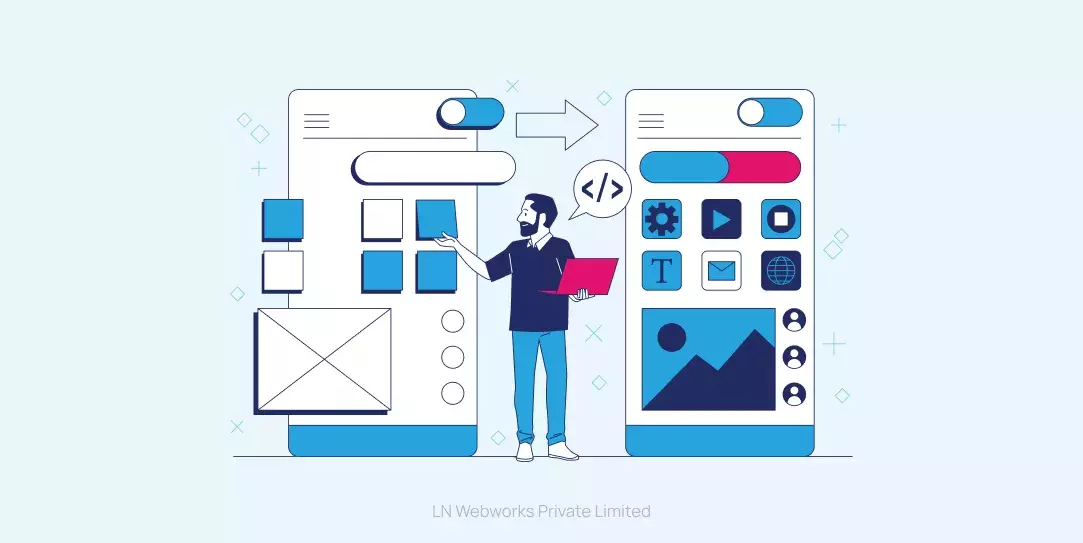Subscribe To Our NewsLetter
Share This Post:
The ubiquity of mobile apps makes it seem as if the world is being driven by them. According to research, 8.93 million apps exist in the world today. Besides, an average smartphone owner uses around 9-10 apps per day and 30 in a month. In light of these revelations, it is certain that mobile application development can help businesses reap benefits galore. Increased brand awareness, wider customer reach, escalated conversions, and profits are some of them.
Inspired by these tremendous benefits, it is natural for you to feel prompted to invest in mobile application development. However, before you take the leap, it is imperative to get yourself familiarized with the process in detail. It will unarguably beacon you on the right path and ensure you reap enormous payoffs from your investment.
9 Key Phases Of Mobile App Development Process
Realizing that you have to follow 9 dedicated steps might give you heartbreak. You may wonder why such a long and tedious process. But, believe it, there is nothing to worry about. The process may seem long but you can breathe a sigh of relief as you don’t have to do everything on your own. You can hire an eminent app development company such as LN Webworks to create a phenomenal mobile app for you. Besides, you may find the process tedious but for experts, it is a piece of cake.
So, relax and take a deep dive into the intriguing process of mobile application development.
1. Introspect and identify your goals
Before you get psyched up to create your mobile app, it is crucial to introspect and identify your agenda behind the project. Ask yourself what is the driving force behind your investment and pen down your responses. Your vision behind the project will ultimately lay the foundation for the app creation process.
Without clear intentions, you may lose track of things and find yourself stuck or miss making your investment fruitful for your business. Once you have a clear set of goals with you, do not forget to set well-defined key performance indicators (KPIs) to measure your progress after releasing the mobile application.
For instance, if you aim to enhance customer lifetime value, you should be aware of the current lifetime value your customers offer. Only with this awareness can you track your progress once your mobile app is live and running.
2. Take a deep plunge into your target market
Thoroughly knowing your target audience is the key to leading your mobile application on an upward spiral of success. In light of their age group, geographical location, preferences, interactions with your competitors, and other related factors you can create an app that captivates their hearts without fail.
Besides, you should also conduct thorough research about your competitors. Dig deeper and find out where they lag and what are their unique selling points (USPs). With this knowledge, you can take advantage of what they lack and incorporate appropriate features to outperform their USPs.
As the process might be taxing for you, it is advisable to hire an app development company that promises to assist you with it.
3. Decide the right features to embed
Picking up the right features to embed in your app is imperative to make it appealing. Without customer-centric useful functionalities, no matter how alluring your app’s design, you’ll ultimately end up losing visitors. This calls upon you to conscientiously choose the right features for your app.
You can tap into the preferences of your target audience and the functionalities offered by your competitors’ apps to understand what matters the most to consumers. Remember not to let haste drive your decisions as they’ll ultimately determine the payoffs your reap.
You should also beware of choosing unnecessary features just for the sake of their attractiveness. Flashy features lose their charm the moment customers realize that your app lacks the meaningful functionalities they expected it to possess.
4. Build an intuitive user interface (UI)
Nothing beats an intuitive user interface when it comes to promoting customer delight. If your app functions exactly the way visitors expect it to and they can navigate through it in a hassle-free manner, you are in for tremendous success.
Research suggests that a phenomenal user interface can boost conversion rates by 200%. Who wouldn’t aspire to escalate their conversion rates by such a huge percentage? If you wonder what makes UI so impactful, the answer lies in the fact that it is the primary factor that determines the quality of interactions between the visitors and your mobile application.
If visitors can utilize your app’s functionalities seamlessly they enjoy the experience. In stark contrast, if they struggle to navigate through, they feel frustrated. Given that, it is of utmost importance to build an interactive, simple, engaging, and easy-to-use interface.
This doesn’t mean that you have to compromise with your application’s design and uniqueness. Not at all, the key is to strike a perfect balance between captivating design features and ease of use.
5. Choose an eminent app development company
Mobile application development requires impeccable problem-solving skills, immense knowledge of the intricacies involved in the process, and the ability to shape up engaging user experience. To be precise, creating a captivating mobile app is not a piece of cake. Hence, it is advisable to hire a trusted app development company to do the chore for you rather than breaking yourself against the process.
Eminent app development organizations possess an adept team of app developers, UI/UX experts, project managers, and market research specialists who work in unison to conceive fabulous mobile apps. By hiring them, you can anticipate guaranteed results in congruence with your expectations.
As the market is flooded with app development companies today, it might be perplexing to make the right choice. However, weighing the options against the right parameters can simplify the task for you.
Overall industry expertise, client database, prices, time required, transparency in processes, access to cutting-edge technologies, and cybersecurity tools and features are some parameters that can beacon you toward making the most appropriate choice.
6. Design a minimum viable product (MVP)
As the name suggests a minimum viable product is the version of your app that possesses only the basic functionalities. By initially releasing an MVP you can determine how well your target audience accepts your mobile application and interacts with it. You can also get valuable insights into what the customers expect further and shape up your app accordingly.
All in all, an MVP is a cost-effective way to analyze whether your mobile application will reap the intended results or not and where you need to work next. Once your minimum viable product shows promising results, you can take the leap toward incorporating advanced functionalities. Seems realistic, doesn’t it?
7. Conduct in-depth testing
Meticulous testing is an integral part of the mobile application development process. You cannot afford to release your mobile app with bugs and other unresolved issues. After all, it can have disastrous repercussions for your business’s reputation.
Hence, you ought to conduct in-depth testing of your app before making it available to the users. Examine its functioning, cybersecurity measures, design appeal, user interface, and everything else, and eradicate the issues if any.
8. Launch your mobile application
Once the development team meticulously tests your app and weighs it against all parameters, you are ready to launch it. The euphoria you experience at this step makes all the efforts and challenges you had to face fade in comparison. With immense joy in your heart and wishes for an enormously positive response, you can submit your mobile app to Google Play Store and App Store.
It is crucial to note that both these platforms have their own set of requirements apps have to meet in order to get published. Don’t worry if your app doesn’t meet their requirements in the first attempt, you can improvise it and try again. Besides, they’ll charge some fees before publishing your mobile application.
9. Publicize your mobile app
After publishing your app, it’s time for you to start publicizing it. If your target audience isn’t aware of your app’s existence how will they reach you? In order to encourage them to download your mobile application, you have to knock at their hearts with effective marketing.
As of 2023, there are 4.89 billion social media users in the world. This makes social media one of the most effective platforms for running your marketing campaigns. You can utilize cutting-edge social media marketing tactics to stand apart from the crowd and make your voice reach your target audience.
Influencer marketing can also work wonders in promoting your mobile app. Apart from this, you can also employ fruitful traditional marketing practices such as SMS marketing and television commercials.
Let’s Wrap Up
Mobile apps have become an indispensable part of our lives. We spend a significant part of our daily screen time navigating through our favorite apps. As an entrepreneur, you can use the fondness of mobile applications to your advantage by building one for your business too. Through it, you can reach more consumers, boost user experience, increase your sales, and enhance your revenue.
However, reaping these benefits isn’t as easy as it seems. Millions of mobile applications are available today which leads to fierce competition. The only way to beat it is to create an unmatchable app. An expert team of app developers like LN Webworks can unquestionably make this possible for you. We have a history of surprising our clients with fantastic mobile applications they didn’t even imagine could exist. To have a similar experience, contact us now.
Share This Post:
Author Information

Shikha Kumar
Co-Founder & DirectorI am Solution Architect and my people love to refer me 'Google' for all the critical technical problems that they face.
Master Mobile App Development Process With Us.
Related Articles
December 12, 2022
7 key trends of mobile app development in 2023
July 18, 2022
Top 5 Mobile App Development Frameworks in 2022
May 26, 2023



